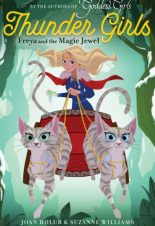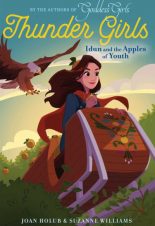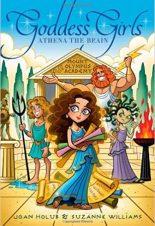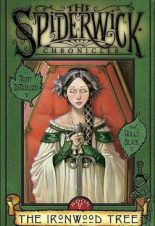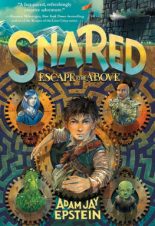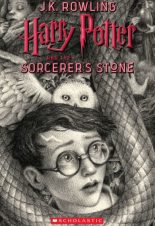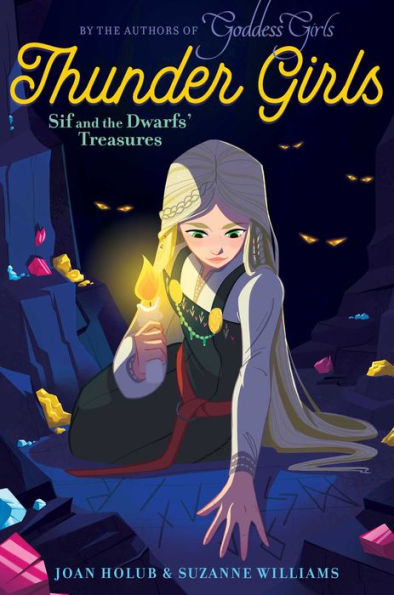
Buy This Book Buy This Series
“Friendship itself was a gift, yet these goddess girls had just given her another gift. A renewed belief in herself as a seer,” Sif. –Sif and the Dwarfs’ Treasures
Sif and the Dwarfs’ Treasures
Thunder Girls #2
by Joan Holub & Suzanne Williams
AR Test
5.4
Score
8+
288
Twelve-year-old Sif attends Asgard Academy, but she’s keeping important secrets from her podmates. No one knows that her magical hair allows the wheat crop to grow. When mischievous Loki cuts her hair in a horrible prank, Sif must rely on her podmates and Loki for help.
Sif has a prophetic dream that gives her a hint on how to solve the problem. Sif and Freya must convince Loki to go to Ivaldi’s sons, dwarves who are skilled blacksmiths. Loki must strike a bargain with them to help Sif get her hair back. An overconfident Loki strikes a deal with the blacksmiths, and as part of the deal he could lose his head—literally.
To make things worse, there are rumors of a looming attack that could hit Asgard Academy. Sif is afraid that Ragnarok, or doomsday, might be about to begin. Is there any way Sif can save the wheat crops and her beloved school?
Fans of Goddess Girls will enjoy this new series which focuses on Norse Mythology. Sif is a relatable character who has a difficult time overcoming her embarrassing insecurities. She doesn’t want anyone to know that she is a seer—or that she has a difficult time reading. As Sif gets to know her podmates better, she realizes that no one, not even a goddess girl, is perfect.
Sif and the Dwarfs’ Treasures has many positive messages that pertain to younger readers. Odin has created the school in order to get people from different worlds to interact. “[He] wished them to understand and appreciate everyone’s differences.” As Sif learns more about her roommates, she realizes the importance of working together. Sif also knows that looks do not define a person’s (or a god’s) character. Even though “many girls found Loki cute,” Sif knows that “a person’s behavior, not his appearance, was what made him attractive.”
Readers will enjoy learning about Sif, who is a well-rounded and caring goddess. Sif and the Dwarfs’ Treasures has interesting characters and actions, humorous puns, and a sprinkle of crushing moments that will entertain readers. Although many of the characters appeared in Freya and the Magic Jewel, the stories do not need to be read in order. Each book is told from a different goddess’s point of view and allows the reader to see that even goddesses need help from others.
Readers who are unfamiliar with Norse mythology will want to read the glossary first. The story introduces Norse mythology in a kid-friendly way, while still staying true to the original stories. Sif and the Dwarfs’ Treasures uses a relatable character to embed important life lessons in an entertaining story that readers will love. Readers will eagerly look for the next book in the series, Idun and the Apples of Youth.
Sexual Content
- Freya has noticed Sif and Thor looking at each other and thinks the two are “crushing on each other” because “crushes often start with just looking.”
- After Sif and Thor have several conversations, Sif thinks, “She likes him, too. As a friend anyway. As far as crushing. . . well. . . time would tell.”
Violence
- The large painted friezes that covered a wall come to life. When Sif and her friends are eating, “all four girls studied the nearby frieze, [and] an armor-clad warrior reached out of it to grab a dish of lemon-flavored snow pudding from a Valkyrie rushed by with a tray of desserts. With a wide grin on his face, the warrior took aim and then flung the snow pudding at a painting of heroes directly across the room.” A food fight begins. Most of the food being thrown “was directed at warriors occupying friezes on opposite walls, but occasionally the thrown food accidentally hit students, too!” They start a food fight several times in the story.
- When Loki says a mean joke, Thor gets angry. “In an instant Thor was across the room, his fists balled to punch Loki out. Before he could follow through[;] however, Loki shape-shifted into fire. ‘‘Yow!’ Thor leaped back, blowing on his singed fingers to cool them.”
- Loki changed into an eagle and stole an apple, “even though he could eat them anytime he wanted in the Valhallateria.” When Loki stole the apple from Idum, she scraped her knee and it was bleeding.
Drugs and Alcohol
- None
Language
- After Loki plays a mean trick, someone calls him a bonehead.
- Loki says, “It’s easy to predict events that have already happened. Even a dummy like Thor could do that!”
- Someone calls Loki a rat.
- Loki calls a group of students idiots.
Supernatural
- Sif takes a class on how to read Runes and the students share their “‘rune-words’ meanings and suggest[ed] prophecies that might be connected to them.”
- In order to hide from Thor, Sif “transformed into a rowan tree. It was one of only two forms she could take, the other being a swan.”
- When Sif was younger, she was “proud” of her talent at prophecy and tried to use her talent at school. However, soon people started calling her “fortune-tattler instead of fortune-teller.” She also lost her best friend. Sif was trying to help her friend by carving the rune word for brave, but Sif made an error and wrote the rune word for poison instead. When Sif’s friend became ill, the friend’s parents wouldn’t allow them to spend time together.
- A dwarf chanted a spell, “For one whole day, you’ll zip your lip. Nothing will you say. Nothing will you sip.” The spell makes it so the Loki cannot speak or eat for a day.
- The large painted friezes that cover a wall come to life. “These painted friezes cover all of the V’s walls and were peopled with heroic warriors who had died in battle. The warriors had been brought into the friezes by Odin’s Valkyries as painted figures that magically came to life toward the end of every meal.”
- Freya has a marble that contains cats and a cart. When Freya says, “catnap,” the cats and cart grow. The first time Freya uses the marble, she thinks, “if anyone had been watching at that moment, the cats and cart would’ve seemed to instantly disappear. However, in reality, they had only shrunk down to a single cat’s-eye marble.”
- Freya drinks juice that won’t make her immortal, but will make her “stay the same age.”
- Several characters are shapeshifters.
- Mimir, an oracle, only has a head. When Sifi sees him, “suddenly a column of bright-blue water shot through one of the tubular slides to bubble up in a tall, fountain-like spout at eye level. Atop the spout sat a disembodied bald head!”
- Sif goes to the library to learn about rune spells and charms. One of the things she learns is that “difficult rune interpretations can sometimes be solved through dreams.” Later in the story, she uses the book’s advice and has a prophetic dream.
- Talking acorns can give students a message. Odin uses one to deliver a message to Sif.
Spiritual Content
- The story focuses on Norse mythology and includes Norse gods and goddesses as characters.
- Sif is a seer, a shapeshifter, and also the “girl goddess of bountiful harvest.” Her power comes from her hair; however, how her hair helps the harvest is never explained. When Sif’s hair is cut, the humans’ wheat fields begin to wither.
- Freya is the goddess of love and beauty. She is also a seer. Another character, Odin, was “the leader of the Asgard gods and the supreme ruler of all the worlds.” (This is not a complete list of the Norse gods that appear in the book.)
“Friendship itself was a gift, yet these goddess girls had just given her another gift. A renewed belief in herself as a seer,” Sif. –Sif and the Dwarfs’ Treasures
Latest Reviews
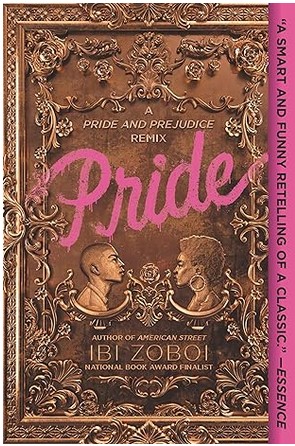
Pride: A Pride & Prejudice Remix

Thieves’ Gambit #1

Dreamology

Monday’s Not Coming
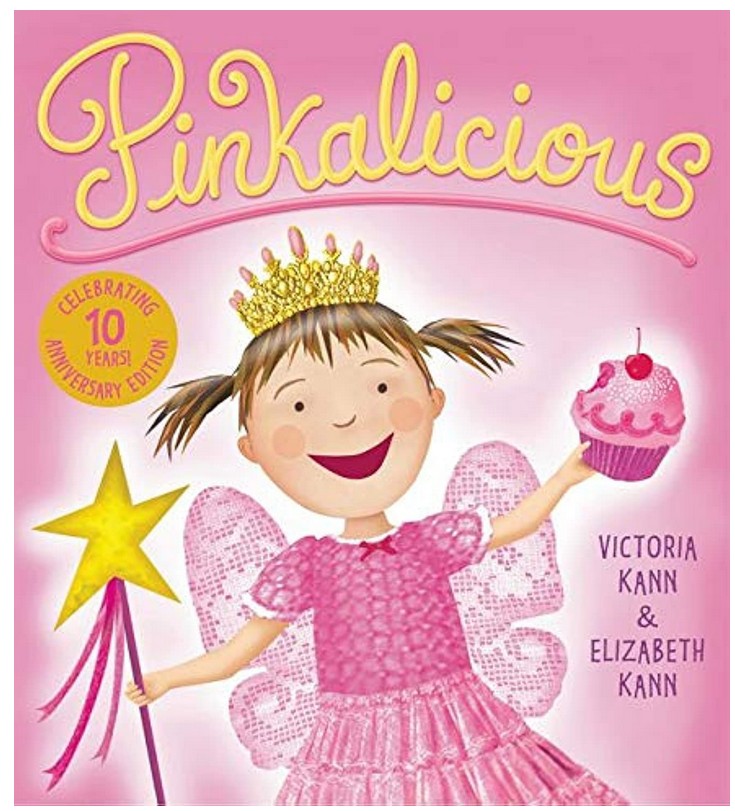
Pinkalicious

Driven

Goodbye Days

Blood of Troy

Will’s Race for Home

